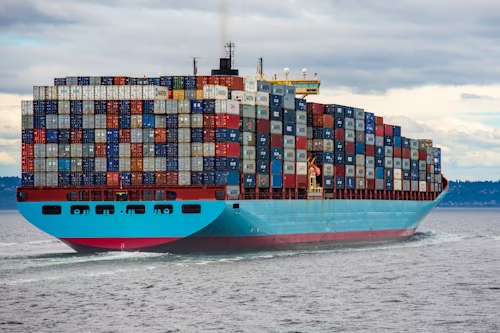Germany’s economic recovery is facing a major crossroads as voters prepare to head to the polls. Economic revival is one of the central issues of the upcoming election, but the challenge may become even tougher due to the looming threat of US import tariffs under former President Donald Trump. If Germany’s coalition government fails to boost growth, it could lead to far-reaching consequences, including a potential rise in the far-right Alternative for Germany (AfD) party’s influence.
Germany, the world’s third-largest economy, has faced serious struggles in recent years. After shrinking in both 2023 and 2024, it marked the first consecutive economic contractions since the early 2000s. The International Monetary Fund (IMF) forecasts minimal growth of just 0.3% for Germany this year. As economic concerns rise, many are questioning whether the country can revive its once-thriving economy.
Germany’s Economic Model Faces New Threats
From 2005 to 2019, Germany’s export-driven economy flourished. During this time, the country benefited from cheap Russian gas, high demand from China, and open global trade. However, the landscape has dramatically changed, and Germany now faces several significant challenges.
A potential second term for Donald Trump could pose another serious threat to the nation’s crucial exporters. “A world where free trade is not the dominant mantra is problematic for Germany,” warned Jacob Kirkegaard, a senior fellow at the Peterson Institute for International Economics. As the global economy evolves, Germany’s reliance on traditional industries, such as vehicles and machinery, could leave it vulnerable in a rapidly changing world.
Economic reform is vital if Germany is to move past stagnation. According to recent polls, Germans are prioritizing economic recovery, with many expressing concerns about the long-term effects of an unaddressed slowdown. “An unreformed German economy is an aging, rigid economy,” Kirkegaard added, stressing the need for change to keep up with global demands.
The Struggles of Germany’s Export Sector
Exports have long been the backbone of Germany’s economy. In 2023, exports of goods and services accounted for more than 43% of the nation’s GDP, the highest percentage among major economies, according to the World Bank. However, the nation’s once-booming export sector is facing multiple hurdles.
Germany’s top exports, including vehicles, machinery, and chemicals, thrived during a period of high demand from China. But as China’s economy slows and its domestic industries, particularly in electric vehicles (EV), grow, Germany’s market share has been shrinking. Chinese manufacturers like BYD and Xpeng have surged ahead with EV production, leaving German companies scrambling to catch up.
The transition to electric vehicles has been particularly challenging for Germany’s iconic automakers, such as BMW, Mercedes, and Audi. These companies, historically reliant on fossil-fuel engines, have been slow to adapt to the shift toward electric vehicles. Meanwhile, competitors like Tesla and Chinese automakers have outpaced them in scaling up EV production.
Rising energy costs have also put additional strain on German industry. Following Russia’s invasion of Ukraine in 2022, Europe was forced to turn to more expensive energy sources. This shift has significantly impacted many German companies, forcing them to scale back production or shut down altogether.
Lars Kroemer, chief economist at Gesamtmetall, an association representing metal and electrical engineering industries, noted, “We are in the midst of deindustrialization.” Germany’s economic model relies heavily on specialized industrial companies that produce high-value goods, but these industries are increasingly facing financial pressures.
Beyond rising energy costs, Germany’s strict regulations and high taxes have made life difficult for businesses. The country’s “debt brake” limits government borrowing, making it harder to invest in infrastructure and digitalization. “Our bureaucratic burden is higher than in other countries,” said Achim Wambach, president of the Leibniz Centre for European Economic Research (ZEW).
Trump’s Tariffs and Their Potential Fallout
One of the most pressing threats to Germany’s economy comes from the ongoing trade tension with the United States. Since returning to office in January, former President Trump has imposed a 25% tariff on steel and aluminum, set to take effect in March. The move is expected to be followed by additional tariffs on imports, including a 25% duty on automobiles, semiconductor chips, and pharmaceuticals, which may begin in April.
If these tariffs take effect, it could harm German exporters, particularly in the automotive and manufacturing sectors. The United States is Germany’s largest single market, accounting for 10% of its total exports. If US producers pass these costs onto consumers, German products may become less competitive against domestic alternatives.
The impact on the auto industry could be especially severe. “Every additional push against automakers is bad news for the industry,” noted Wambach. Approximately 1.2 million German jobs depend on exports to the US, making up about 2.6% of total employment, according to Prognos, a Swiss research firm.
While the direct effects of tariffs are concerning, the indirect consequences could be just as damaging. Trump’s announced tariffs on imports from countries like Mexico and China could disrupt global trade patterns, leading to more competition for German exporters. As Michael Böhmer, chief economist at Prognos, explained, “The global economy functions like a network. A tariff in one place affects the entire system.”
The Need for Economic Overhaul
To secure its future, Germany must address more than just trade tensions. Some experts argue that the country’s economic model, which has long depended on traditional industries, needs an overhaul to adapt to the challenges of the 21st century.
Böhmer cautioned, “If Germany fails to shift from aging industries—like cars, machinery, and steel—to future-oriented sectors, such as AI and green technologies, it will no longer be the world’s third-largest economy.” Germany must act quickly to diversify its industries and invest in innovative sectors that can drive growth and ensure long-term stability.
Germany’s economic future hinges on rapid reforms. Without a clear strategy for adapting to the changing global landscape, stagnation and decline could become the new normal for Europe’s powerhouse economy.
For more information on global economic developments, visit Financial Mirror.
